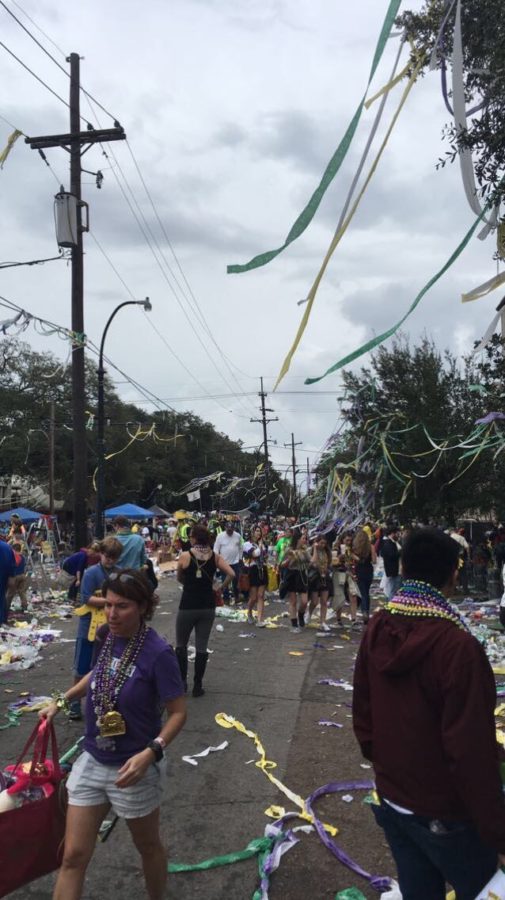During Mardi Gras, we should consider environmentalism in New Orleans
Beads, streamers and trash litter the streets and hang from trees after a parade during last year’s Mardi Gras. Nearly 1,200 tons of trash were collected during the 2018 Mardi Gras parade season, with artifacts like beads hanging from trees remaining in the city for years to come. ANDERSON LEAL/The Maroon. Photo credit: Anderson Leal
February 22, 2019
It’s no secret that Mardi Gras is a fairly wasteful holiday. Each year, an estimated 25 million pounds of made-in-China plastic beads are dumped on the streets of our city. Smithsonian Magazine reported that these beads are often coated with lead, a fact that is worrisome when considering the fact that they are held by children and dangle from every tree in the city. Last year, just shy of 1,200 tons of trash were collected during the 2018 parade season. For years, the city measured this trash — and not in a determination of damage, but in a determination of success. The more trash, it seemed, the more successful our Mardi Gras was.
While the tradition of throws and parades is integral to our culture and has become synonymous with New Orleans, the environmental impact of such celebrations is beginning to become pertinent.
For many decades, we have been able to ignore the looming impact of climate change. But environmental catastrophes in recent years have deeply affected North Americans. Last summer, wildfires in California claimed lives and more than a million acres. Each winter, it seems we face a new “polar vortex” in which the country receives record-breaking cold temperatures. Each summer, we face record-breaking heat waves — like the one this past summer that killed 70 people in Quebec.
Although residents of New Orleans are used to summer heat, we still spend every hurricane season holding our breath. In the past two years, we’ve avoided storms like Hurricane Harvey and Hurricane Florence. And although it’s spooky to admit it, we only avoided them by chance.
Just south of the city in the marshes and bayous, the land is collapsing. According to the U.S Geological Survey’s most recent analysis in 2011, Louisiana lost roughly a football field of land per hour. Scientists say the culprit is reduced sediment flow, subsidence, and sea level-rise — all of which are naturally occurring phenomenons that have been heightened to disastrous effects by human interference.
Culturally, New Orleans adopts a laissez-faire attitude about many things. It’s part of what defines our city culturally. We are a place with relaxed alcohol laws, slow-paced public transit that’s remained in the same form since as early as 1830, and a reputation for being a unique city to vacation in the South. New Orleans is different than the fast-paced bustle of other urban metropolises like New York, Chicago or San Francisco. The city values having a good time — laissez les bons temps rouler.
Yet, perhaps laissez faire is dooming us.
We complain about the poor condition of our streets, our school systems and our local and political inadequacy. Average police response time is reported to be more than an hour, with the New Orleans Police Department simply lacking the manpower to enforce each law. There is no glass allowed in your curbside pickup recycling – along with a myriad of other common recyclables, simply because we don’t have the resources to recycle them.
And now, we face a threat of environmental damage and destruction, which is only heightened by our indifferent attitude.
It’s said — no, it’s true — that New Orleans is sinking. Hearing it this way, it’s hard not to think about the sinking of the Titanic and the way that some passengers on board simply sat there, poured a glass of brandy, and listened to the violin play. But the Titanic was a massive ship that contained materials they could have easily built a raft from in the four-hour sink time.
Likewise, New Orleans is a city that deserves our respect and preservation for generations to come. And in order to preserve, we must become conscious of our environmental impact and degradation on the region. We must find solutions to adapt without losing our culture. They exist in biodegradable beads being engineered by students at LSU, in potential glass recycling and repurposing as beads. They exist in the potential that lies in the engineers, the youth, the students and the residents — anyone who is dedicated to keeping New Orleans afloat.
As we prepare for another Mardi Gras season, we’ll see discarded beads and literal tons of trash rest on our streets, ready to be swept away to a landfill. Somewhere South, while this happens, the land will slowly be sinking away into the Gulf. We’ll grow closer to hurricane season, and we’ll start holding our breath again.
But instead of laissez faire — instead of sitting back and letting things take their own course — we ought to wonder what we can do for our city. We have interfered with the course of our natural surroundings, and as citizens of New Orleans, we should consider environmentalism and activism. Otherwise, we will soon be holding our breath year round.







Ellen Byron • Feb 22, 2019 at 10:03 pm
Fantastic editorial!!! Bravo.